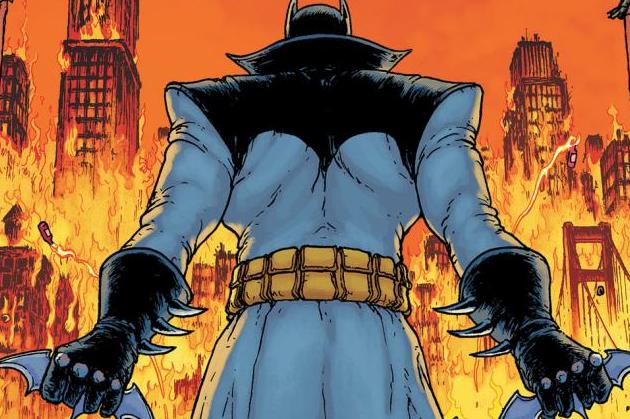Batman Incorporated #5
WATCH OUT FOR THAT SPOILER!!!
Batman Inc. is a mixed bag. From the beginning, it's been an odd, mildly trippy, sometimes simply confusing thrill ride through Grant Morrison's wildly contorted mind. This is your brain on Batman. Bam. Ka-pow. But the truly mind-blowing element is ultimately not the complexity of the story Morrison is capable of juggling, or the creativity he exhibits in constructing its intricate puzzle-pieces, but the sheer scope of the vision he has for the long-term future of the Bat-family.
Bam. Ka-pow.
Starting with the basics: Chris Burnham, who first came to my attention a few years ago during his excellent work on Cladio Sanchez's equally excellent Amory Wars, is without question a unique and recognizable artist. He's no Frank Quitely, but then again he doesn't need to be. My only gripe is that perhaps his style is less perfectly suited for the tone of a Batman story than a science fiction epic like Amory Wars. Nathan Fairbairn's coloring job is perhaps slightly too colorful, and Burnham's lines, while retaining the sense of grittiness and dirt that defines Gotham City, perhaps render the characters slightly too... soft? Not a bad job, and by no means unreadable, but slightly off—incidentally, much like the renowned and spectacular Frank Quitely's work on Batman and Robin a few years past.
The story itself leads from issue #4, in which the numerous agents of Batman Incorporated end a decisive battle against the clandestine Leviathan organization—led, to nobody's surprise, by the nefarious Talia Al Ghul. What happens next is a definitive moment in the lives of Bruce Wayne and his son, Damian. And here's where it gets complicated.
It's been revealed since the inception of Batman Incorporated that Talia, the mother of Bruce Wayne's son, has far greater plans than we originally thought. Her aspirations of conquest rival even those of her father Ra's, and as Damian's mother she has managed to drive a wedge of doubt into the relationship between the other sons of the Bat-family. It is this doubt, and a vision of the future, that prompt Bruce to expel his own son and loyal partner from Batman Incorporated.
Now hold on a moment. Remember Batman #666? It's one of my favorite single issues of all time. If you haven't read it, do so. In it, a dystopian future is revealed in which Gotham has continued to deteriorate after the unexplained death of Bruce Wayne, and a seemingly immortal Damian now wears his father's coat-of-arms and fights crime as the Batman. Batman Inc. #5 follows this timeline further forward, to Gotham's apocalypse—burning and desecrated, filled with eerily grinning Joker-toxin zombies, and utterly collapsing as the scowling Damian Wayne fights for survival, barricaded with his old enemies and reluctant allies in the remains of Arkham Asylum. In the end, the destruction becomes total as the president drops a nuclear weapon, obliterating Gotham City along with what remains of the Batman mythos. Bam. Ka-pow. In the background stands a sinister, grinning figure uncannily similar to Bruce Wayne. And back to the present we come.
Now, I love Grant Morrison's writing and Batman Inc. has been an immensely satisfying title so far. The Batman #666 timeline is my preferred version of Batman's future, and Damian Wayne is one of my favorite characters. But this issue left me confused. Who is the mysterious figure who destroys Gotham? Why exactly is Bruce expelling Damian? Cliffhangers I understand, but when I finish reading and feel no resolution or progress in the story, it impedes my enjoyment. I have faith in Morrison's vision for the end of this story, which will be wrapping up summer of 2013. But with staccato pacing, vague exposition and (in particular) Bruce's clumsy, confusing dismissal of Damian, I have to say it didn't quite live up to my expectations.
It's still one of my must-reads this month, and will be until it ends in issue #12. Morrison has done more for the Batman franchise than anyone else since Chuck Dixon, or maybe even Adams and O'Neil, as far as revitalizing it, making it personal, and turning it into something larger than life after long years of Bat-boredom. His work paved the way for the wonders Scott Snyder is currently doing on the main Batman title, and stirred the whimsical sweetness of Silver Age comics back into the bitter flavor of the modern-day—some would say Dark Age—costumed crimefighter. This is Morrison's final Batman epic, and I cannot wait to see the Ragnarok of this breathtaking and mystifying Batman mythology.
Bam. Ka-pow.





